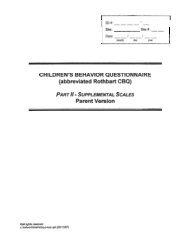A Contextual Investigation of Three-Digit Addition and Subtraction
A Contextual Investigation of Three-Digit Addition and Subtraction
A Contextual Investigation of Three-Digit Addition and Subtraction
Create successful ePaper yourself
Turn your PDF publications into a flip-book with our unique Google optimized e-Paper software.
A CONTEXTUAL INVESTIGATION OF THREE-DIGIT ADDITION AND SUBTRACTION 143<br />
situations in which the students “packed” <strong>and</strong> “unpacked” Unifix cubes into bars or<br />
rolls <strong>of</strong> ten.<br />
To help students develop a rationale for these activities, the teacher explained that<br />
the factory manager, Mr. Strawberry, liked his c<strong>and</strong>ies packed so that he could tell<br />
quickly how many c<strong>and</strong>ies were in the factory storeroom. In order to record their packing<br />
<strong>and</strong> unpacking activity, the students developed drawings <strong>and</strong> other means <strong>of</strong> symbolizing<br />
as models <strong>of</strong> their mathematical reasoning (Gravemeijer 1997). The goal <strong>of</strong><br />
subsequent instructional activities was then to support the students’ efforts to mathematize<br />
their actual <strong>and</strong> recorded packing <strong>and</strong> unpacking activity so that they could interpret it<br />
in terms <strong>of</strong> the composition <strong>and</strong> decomposition <strong>of</strong> arithmetical units. To encourage this<br />
process, the teacher elaborated on the students’ contributions by describing purely numerical<br />
explanations in terms <strong>of</strong> the packing activity <strong>and</strong> vice versa. This, in turn, served<br />
to support the students’ development <strong>of</strong> situation-specific imagery <strong>of</strong> the transactions<br />
in the factory that would provide a foundation for students’ mathematical reasoning<br />
throughout the sequence.<br />
In a subsequent phase <strong>of</strong> the sequence, the students were asked to make drawings to<br />
show different ways that a given number <strong>of</strong> c<strong>and</strong>ies might be arranged in the storeroom<br />
if the workers were in the process <strong>of</strong> packing them. For example, 143 c<strong>and</strong>ies might be<br />
packed up into one box <strong>and</strong> four rolls, with three single pieces, or they might be stored<br />
as twelve rolls <strong>and</strong> twenty-three pieces. When the students first described their different<br />
ways, they either drew pictures or used tally marks or numerals to record <strong>and</strong> explain<br />
their reasoning. Later, the teacher encouraged all the students to use numerals. To<br />
this end, she introduced an inventory form that was used in the factory to keep track <strong>of</strong><br />
transactions in the storeroom. The form consisted <strong>of</strong> three columns that were headed<br />
from left to right, “Boxes,” “Rolls,” <strong>and</strong> “Pieces” (see fig. 18.1). The issue <strong>of</strong> how to<br />
symbolize these different ways <strong>and</strong> thus the composition <strong>and</strong> decomposition <strong>of</strong> arithmetical<br />
units became an explicit topic <strong>of</strong> discussion <strong>and</strong> a focus <strong>of</strong> activity. For example,<br />
a typical suggestion for verifying that 143 c<strong>and</strong>ies could be symbolized as twelve<br />
rolls <strong>and</strong> twenty-three pieces was to pack twenty pieces into two rolls <strong>and</strong> then pack ten<br />
rolls into a box, with three pieces remaining, as shown in figure 18.1.<br />
As a final phase <strong>of</strong> the sequence, the inventory form was used to present addition <strong>and</strong><br />
subtraction tasks in what was, for us, the st<strong>and</strong>ard vertical-column format (see fig.<br />
18.2). These problems were posed in the context <strong>of</strong> Mr. Strawberry’s filling orders by<br />
taking c<strong>and</strong>ies from the storeroom <strong>and</strong> sending them to shops or by increasing his inventory<br />
as workers made more c<strong>and</strong>ies. The different ways in which the students conceptualized<br />
<strong>and</strong> symbolized these transactions gave rise to discussions that focused on<br />
the students’ emerging addition <strong>and</strong> subtraction algorithms.






